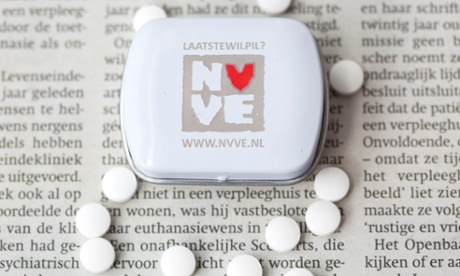
A touching set of photographs shows a man, just in his 70s, surrounded by his family, being administered euthanasia medication. The pictures hang opposite the desk of Steven Pleiter, the director of the Levenseindekliniek – End of Life clinic – in The Hague, Holland, and he points to them with pride as an example of a “good death”. Pleiter helped pulmonologist Petra de Jong, now retired, start the Levenseindkliniek in 2012.
The man in the photos was not terminally ill, but he had been diagnosed with borderline dementia. He did not want to go where the illness would take him, or leave the request to die until he was no longer considered capable of understanding the implications. This is just one of the cases where the clinic has lived up to de Jong’s belief that people may decide themselves when life has become a matter of “unbearable suffering”. Controversially, she also declared that euthanasia should be on offer to anyone over 70 who is convinced that they have reached the end of the life they want to live.
Despite the defeat of the assisted dying bill, legalising euthanasia is seen by many in the UK as a way of enabling people to choose a humane and dignified death, and to die in their own homes with friends and family if they wish. Of all deaths in the Netherlands, 3.4% are the result of euthanasia, which was sanctioned after the NVVE Right to Die organisation campaigned to get the 2002 Termination of Life on Request and Assisted Suicide Act on the statute books. Under this law, doctors may perform euthanasia on anyone with “unbearable suffering”. This goes beyond terminal illness to include somatic illnesses without an identifiable end, dementia, mental illnesses and the belief that meaningful life is completed, and illnesses for which there is no available and suitable treatment. This permits life to be ended after intensive interviewing and assessment, as well as the approval of a doctor outside the process.
In Holland there is 85% support for euthanasia, and 5,300 in 2014 took this option, with the majority of cases performed by GPs. It is only when people are refused by their GP – in cases where the refusing doctor may have a moral or religious objection or be unconvinced that it is within the law – that they turn to the NVVE and the Levenseindekliniek for help.
Pleiter was drawn to the euthanasia movement after seeing his mother suffer a stroke that wrecked her life, yet she could not be helped to die and endured another four difficult years. For all his Christian upbringing, Pleiter wished she could have been helped to die. He says: “I know the argument that we need to protect people from the chance that life will improve in the future, or that if they suffer in dignity it is inspirational to others. At the same time, if I see someone really suffering and wanting help to die, it seems morally right to give that help.”
This thinking extends to anyone over the age of 18 who fits the criteria. Pleiter tells of a 22-year-old young man paralysed from the neck down in a sports accident who had thought life tolerable until he began to go blind. “At this point, he was adamant he did not want to go on. We agreed to help and his parents were utterly supportive.”
More controversial was the euthanasia of a 47-year-old woman who had incurable tinnitus “like train brakes constantly shrieking in her head. There was no treatment and no forseeable end to it – she convinced us her suffering was unbearable.”
The Levenseindekliniek clinic does not charge and receives funding from the health system. Pleiter acknowledges that “we go to the borders of the law, but never outside. We are a professional organisation but one that believes you look at the fact that some people want to die as enabling them to accept responsibility for their choice. It is about using compassion to give them the dignity to go when they wish.”
Meanwhile the NVVE is campaigning to go further. They support the plea from the Dutch Paediatric Association that the age 12 limit, with parental approval, for “terminally ill children in unbearable suffering” be scrapped. Eduard Verhagen, a paediatrics professor at Groningen University, who is on the organisation’s ethics commission, said: “We feel that an arbitrary age limit such as 12 should be changed and that each child’s ability to ask to die should be evaluated on a case-by-case basis.”
They would also like the “last-will pill” – medication with which a person can kill themself – to be made available. This is certainly further than the UK’s proposed assisted dying bill – rejected last week – would have gone, but that bill would have been a vital first step, according to a group of senior doctors and nurses. The group wrote to the Guardian last week claiming that the law on assisted dying is “dangerous, cruel” and forces terminally ill patients to end their lives abroad. They urged that it would also have allowed a practice already happening “behind closed doors” to come into the open.
New legislation might have granted Bob Cole, 68 – who watched his wife Ann Hall take her life at Dignitas just 18 months ago – his wish that the law would legalise euthanasia for people such as him. Suffering an aggressive terminal cancer himself, he, too, went to die at Dignitas surrounded by four of his closest friends. He said: “I should have been able to do this at home.”
It would also have helped people such as my elderly friend – a frail and unwell 90-year-old with no family, who is likely to die alone in hospital – to be granted their wish to end it now and not “go on to the bitter end, doing what good to anyone?”

